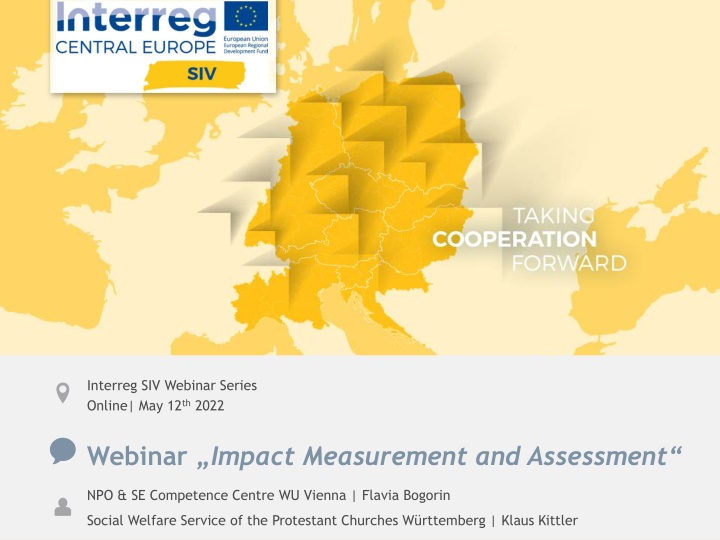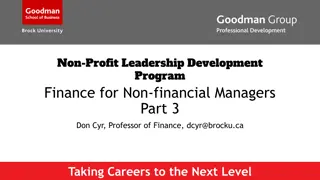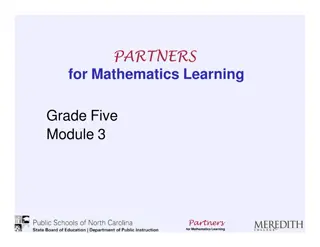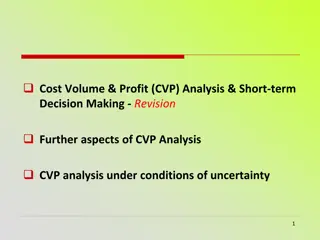Impact Measurement and Assessment in Non-Profit and Social Enterprise Settings
Impact measurement and assessment are crucial for analyzing the effects of interventions on beneficiaries and the environment. This webinar series delves into methods, tools, and key findings related to Social Return on Investment (SROI) analysis, discussing potential and limitations with experts. Understanding the impact value chain is essential for evaluating intended and unintended outcomes in projects. Source materials provide valuable insights for non-profit organizations, businesses, and entities with social impact.
Download Presentation

Please find below an Image/Link to download the presentation.
The content on the website is provided AS IS for your information and personal use only. It may not be sold, licensed, or shared on other websites without obtaining consent from the author.If you encounter any issues during the download, it is possible that the publisher has removed the file from their server.
You are allowed to download the files provided on this website for personal or commercial use, subject to the condition that they are used lawfully. All files are the property of their respective owners.
The content on the website is provided AS IS for your information and personal use only. It may not be sold, licensed, or shared on other websites without obtaining consent from the author.
E N D
Presentation Transcript
Interreg SIV Webinar Series Online| May 12th2022 Webinar Impact Measurement and Assessment NPO & SE Competence Centre WU Vienna | Flavia Bogorin Social Welfare Service of the Protestant Churches W rttemberg | Klaus Kittler
AGENDA Part 1: Methodsand toolsfor analysingimpact Whatisimpact? Howtoconductan impactanalysis? Whatisan SROI analysis? Part 2: Key findingsfromthe InterregSIV evaluation The SROI analysisofthe German voucher programme (W rttemberg) Part 3: DiscussionwithKlaus Kittler (SWSW) about thepotential and limitationsoftheSROI method 2 TAKING COOPERATION FORWARD
AGENDA Part 1: Methodsand toolsfor analysingimpact Whatisimpact? Howtoconductan impactanalysis? Whatisan SROI analysis? Part 2: Key findingsfromthe InterregSIV evaluation The SROI analysisofthe German voucher programme (W rttemberg) Part 3: DiscussionwithKlaus Kittler aboutthe potential and limitationsoftheSROI method 3 TAKING COOPERATION FORWARD
WHAT IS IMPACT? Impact describes those (positive and/or negative) changes that can be observed in beneficiaries or affected person (e.g. individuals, groups, corporations, society) as well as in the environment after an intervention has taken place Impacts can occur short-, medium- and long-term Impacts can occur at micro, meso and macro level Where do the impacts arise structurally? Impacts can roughly occur in six different dimensions: For which stakeholders? political social economic cultural ecological physical/psychological When do the impacts occur? Which time horizon is relevant? Which impacts? Source: Gr nhaus, Christian/Rauscher, Olivia (2021): Impact and impact analysis in non-profit organisations, businesses and organisations with social added value. NPO & SE Competence Centre. Download: https://short.wu.ac.at/working-paper-impact-EN Then et al. (2017): Social Return on Investment. Palgrave Macmillan. https://www.springer.com/de/book/9783319714004 4 TAKING COOPERATION FORWARD
AT THE CORE OF EACH IMPACT ANALYSIS: THE IMPACT VALUE CHAIN Dead- weight _ = IntendedImpact IntendedOutcome Broad Impact Input Activities/ Services Analysis + + Output (Resources) Unintended Outcome Dead- weight _ = UnintendedImpact = = Social Value Social Added Value Input refers to all resources invested in the analysed project or organization (money, time, skills, knowledge). Activities refers to those services or products designed/carried out with the invested input. Output refers to the extent and quantity of services or products delivered. Intended/ Unintened Outcome refers those positive and/or negative changes that can be observed in beneficiaries or affected persons after the activity or service/product has been performed or consumed. In sum it defines the Social Value of an intervention. Deadweight refers to those outcomes that would have occurred anyway (ceteris paribus), even without the concrete activities. Intended/ Unintended Impact refers all those outcomes that occur only due to the intervention analysed, taking deadweight into account. In sum it defines the Social Added Value of an intervention. Source: Gr nhaus, Christian/Rauscher, Olivia (2021): Impact and impact analysis in non-profit organisations, businesses and organisations with social added value. NPO & SE Competence Centre. Download: https://short.wu.ac.at/working-paper-impact-EN Then et al. (2017): Social Return on Investment. Palgrave Macmillan. https://www.springer.com/de/book/9783319714004 5 TAKING COOPERATION FORWARD
IDENTIFYING AND STRUCTURING IMPACT THE IMPACT MODEL An Impact Model is set up for a project/intervention or can be set up for an entire organisation. An Impact Model consists of various impact value chains. For each stakeholder one impact value chain. It shows the overall social added value/ impact of the whole organisation or a sector It might show the interconnectedness and synergies between different project or services of an organisation. It can serve as a basis for an impact oriented strategic development, for example to identify potential partners for cooperation to increase the impact Source: Gr nhaus, Christian/Rauscher, Olivia (2021): Impact and impact analysis in non-profit organisations, businesses and organisations with social added value. NPO & SE Competence Centre. Download: https://short.wu.ac.at/working-paper-impact-EN 6 TAKING COOPERATION FORWARD
STEPS OF AN IMPACT ANALYSIS Source: Gr nhaus, Christian/Rauscher, Olivia (2021): Impact and impact analysis in non-profit organisations, businesses and organisations with social added value. NPO & SE Competence Centre. Download: https://short.wu.ac.at/working-paper-impact- EN 7 TAKING COOPERATION FORWARD
IMPACT MEASUREMENT: FOR WHAT PURPOSE? Control of the organization on the basis of key impact indicators Establishment of an impact controlling system Impact-orientedcontrol Reputation building, branding Establish/secure legitimacy in external perception External communication Mobilize resources Establish/secure legitimacy towards financiers e.g. social impact investors Finding investors, fundraising Improve strategy development; basis for strategic decisions Promoting organizational learning; optimizing processes Increasing employees motivation and satisfaction Strategic and organizational development Enter into cooperation that are in the spirit of social value chains Increase social added value through scaling of the business model Strategic cooperation and scaling The purpose, the resources and the possibilities of data collection define the type and breadth of an impact analysis Source: Gr nhaus, Christian/Rauscher, Olivia (2021): Impact and impact analysis in non-profit organisations, businesses and organisations with social added value. NPO & SE Competence Centre. Download: https://short.wu.ac.at/working-paper-impact-EN Then et al. (2017): Social Return on Investment. Palgrave Macmillan. https://www.springer.com/de/book/9783319714004 8 TAKING COOPERATION FORWARD
IMPACT MEASUREMENT: THE SOCIAL RETURN ON INVESTMENT (SROI)-ANALYSIS Source: Gr nhaus, Christian/Rauscher, Olivia (2021): Impact and impact analysis in non-profit organisations, businesses and organisations with social added value. NPO & SE Competence Centre. Download: https://short.wu.ac.at/working-paper-impact-EN Then et al. (2017): Social Return on Investment. Palgrave Macmillan. https://www.springer.com/de/book/9783319714004 9 TAKING COOPERATION FORWARD
ADVANTAGES OF IMPACT MEASUREMENT Abandonment of pure input-output orientation Includes stakeholder perspective Analysis of the needs and benefits of stakeholders (resp. impacts of an intervention) leads to a better understanding of (lack of) services Evidence of mission fulfillment Helps to define goals and an impact model and to better understand one's own activities effect beneficiaries, other stakeholders and society Increase in the effectiveness, efficiency and quality of service provision Gives evidence where changes are particularly effective Provides adequate legitimacy for activities of non-profit organizations and social businesses Provides decision support for investors between different programs, projects, organizations Benchmarking (depends on the method) Impact orientation opens up room for innovation Source: Gr nhaus, Christian/Rauscher, Olivia (2021): Impact and impact analysis in non-profit organisations, businesses and organisations with social added value. NPO & SE Competence Centre. Download: https://short.wu.ac.at/working-paper-impact-EN Then et al. (2017): Social Return on Investment. Palgrave Macmillan. https://www.springer.com/de/book/9783319714004 10 TAKING COOPERATION FORWARD
CHALLENGES OF IMPACT MEASUREMENT Can a consistent logical link between services (output) and effects (impact) be demonstrated? Problem of the imputability of effects How many level of impact should be included? (e.g. income = benefit for employees Income is spent and creates jobs again ...) Can indicators be found that measure impacts validly? How complex is data collection and measurement? Certain facts are extremely difficult to measure (e.g. life satisfaction in patients with severe dementia) Difficulty of subjectivity Objective measurement of impacts is often difficult; frequently, only a subjective evaluation of achieved impacts can be recorded Lack of standards in impact analysis and measurement Many different approaches Source: Gr nhaus, Christian/Rauscher, Olivia (2021): Impact and impact analysis in non-profit organisations, businesses and organisations with social added value. NPO & SE Competence Centre. Download: https://short.wu.ac.at/working-paper-impact-EN Then et al. (2017): Social Return on Investment. Palgrave Macmillan. https://www.springer.com/de/book/9783319714004 11 TAKING COOPERATION FORWARD
AGENDA Part 1: Methodsand toolsfor analysingimpact Whatisimpact? Howtoconductan impactanalysis? Whatisan SROI analysis? Part 2: Key findingsfromthe InterregSIV evaluation The SROI analysisofthe German voucher programme (W rttemberg) Part 3: DiscussionwithKlaus Kittler aboutthe potential and limitationsoftheSROI method Download study report: https://short.wu.ac.at/sroi-siv-en 12 TAKING COOPERATION FORWARD
AIMS OF THE STUDY Presentation of the short- as well as medium- and long-term social and economic impacts of the support programme "Employment Vouchers"/ the Interreg CE "Social Impact Voucher" (SIV) Programme in Germany (W rttemberg) Monetary evaluation of the effects and their comparison with the investments made Research Questions: FF 1: What are the impacts of the "Employment Vouchers" programme of the Social Welfare Service of the Protestant Churches in W rttemberg? FF 2: To what extent (quantity) do the identified impacts occur? FF 3: How can the identified and quantified impacts be monetised? FF 4: What is the total monetised benefit of one euro invested in the voucher programme? FF 5: Which Sustainable Development Goals (SDGs) are achieved through the identified impacts? 13 TAKING COOPERATION FORWARD
SCOPE AND DESIGN OF THE STUDY Analysis period: the year 2019 Inclusion of all program participants and employment providers who participated in the voucher program in 2019 in the analysis: 126 programme participants (65 volunteers, 2 mini-jobs, 59 jobs subject to social insurance contributions) 24 employment agencies Data Collection: Secondary material research and analysis > Literature & statistical data research > Review and analysis of internal documents (e.g. application list) Qualitative survey of key stakeholders (9 personal and telephone interviews) Quantitative questionnaire surveys: > Collection of financial, performance and output data via Excel form at Social Welfare Service W rttemberg > Offboarding survey of selected programme participants (n=47) > Collection of output, financial and impact data from employment providers by means of a quantitative telephone survey (n=12) 14 TAKING COOPERATION FORWARD
STAKEHOLDERS INCLUDED Programme participants (job seekers) Personal or family environment of the participants Stabilisation or improvement of the family situation; relief of strain Excluded stakeholders Employment companies and church congregations Future perspectives; additional income; daily routine/ structure; development of professional as well as personal and social skills; mental stress Partner organisations; EU/ Interreg Central Europe; Social Welfare Service W rttemberg; Broader social environment of participants Image improvement; network expansion; savings in terms of recruitment costs Work colleagues of the participants (key employees) Sensitization regarding the target group; work relief; excessive demands on the team due to participants social and personal needs Investors/ Regional Church SIV Voucher Program Stakeholder is only considered on the input side State (federal government, federal states, stricts, municipalities) Additional tax and duty revenue through the employment of participants, SWSW employees and employment companies employees. Employees of the Social Welfare Service W rttemberg Social insurance institutions Additional social insurance contributions of the participants, the employees of SWSW and employment companies Employment agencies/ job centres Suppliers Income; broadening horizons; positive feeling additional orders Ease of workload; saving on basic security benefits for participants with jobs subject to social insurance contributions 15 TAKING COOPERATION FORWARD
Footer IMPACT MODEL (EXCERPT) Stakeholder Input Activities Output Effects Programme participants (job seekers) Time Placement, employment, support Number of participants placed, employed and supported Sense of purpose and the opportunity to make a contribution to society Skills Creation of routine and structure in everyday life Willingness to be helped Knowledge enhancement or acquisition of professional competences Mental stress or mental overload due to the world of work (e.g. due to conflicts at work, assumption of responsibility, stress) Employment companies and church congregations Additional financial resources workplace promotion, support with recruitment activities; mediation Number of participants placed, employed and supported Savings in terms of recruitment costs and time facilitation due to the preparatory work of the Social Welfare Service W rttemberg improved image and recognition through employment of the target group Time and personnel resources for support Establishing relationships with potential cooperation partners and network expansion 16 TAKING COOPERATION FORWARD
Footer CALCULATION METHODS (EXCERPT) MONETIZED EFFECTS Programme participants (job seekers) Creation of routine and structure in everyday life Average costs of a project management / time management seminar Related to the year 2019 multiplied by the number of programme participants who have learned to better struc-ture their daily routine (quantification: voluntary work: 76%; mini-jobs: 62%; jobs sub-ject to social insurance contributions: 47%) minus deadweight: share of participants who would have similar outcomes through alter- native programmes (assumption: voluntary work: 5%, mini-jobs: 5%, jobs subject to social insurance contributions: 10%) Impact 110,409 Employment agencies and church congregations Improved image or recognition through employment of the target group Costs for an online advertising campaign Related to the year 2019 multiplied by the share of employment companies that reported an improved image through the voucher programme (33%) minus deadweight: share of employment companies that would have similar outcomes through alternative programmes (assumption: 25%) Impact 20,790 17 TAKING COOPERATION FORWARD
SROI VALUE 5000000.0 4,330,307 4000000.0 SROI 1 : 4.62 SROI medium-term scenario 1 : 6,10 3000000.0 2000000.0 long-term scenario 1 : 8,38 937 061 1000000.0 .0 Investitionen Mehrwert 18 TAKING COOPERATION FORWARD
Footer INVESTMENT AND ADDED VALUE OF THE VOUCHER PROGRAMME OVERALL VIEW Stakeholder Investments Monetized added value share of total profit Programme Participants 3.368.996 77,80% Social Insurance Institutions 280.342 6,47% Employment agencies/ job centres 264.210 6,10% Employment companies and church congregations 482.549 206.716 4,77% State (federal government, federal states, districts, municipalities) 159.676 117.139 2,71% Work colleagues of the participants 54.446 1,26% Personal/family environment of the participants 35.458 0,82% Employees of the Social Welfare Service W rttemberg 1.653 0,04% Suppliers 1.348 0,03% Investors/ Regional Church 294.835 Stakeholders is only considered on the input side Overall result 937.061 4.330.307 SROI 1 : 4,62 19 TAKING COOPERATION FORWARD
RSUM AND CONCLUSION With an SROI value of 4.62, the voucher programme proves to be particularly effective This value represents only the short-term impacts directly related to the 2019 analysis year. If the effects are extrapolated for the medium and long term, the SROI value increases to 6.02 and 8.38 respectively. The programme participants are by far the main beneficiaries of the voucher programme. The second and third largest social added value is generated by the social insurance institutions and the employment agencies/job centres. The voucher programme makes a significant contribution to the achievement of the Sustainable Development Goals (SDGs) and thus generates socially and economically sustainable added value in addition to monetised added value. 20 TAKING COOPERATION FORWARD
Fusszeile QUESTIONS Thank you for your attention! Do you have any questions? 21 TAKING COOPERATION FORWARD
AGENDA Part 1: Methodsand toolsfor analysingimpact Whatisimpact? Howtoconductan impactanalysis? Whatisan SROI analysis? Part 2: Key findingsfromthe InterregSIV evaluation The SROI analysisofthe German voucher programme (W rttemberg) Part 3: DiscussionwithKlaus Kittler aboutthe potential and limitationsoftheSROI method 22 TAKING COOPERATION FORWARD
DISCUSSION QUESTIONS I Where do you see the need as well as the potential for activating private money for supporting labour market integration? Is this a goal that the Social Welfare Service W rttemberg is actively pursuing? Do you have any good practice examples in this regard? How did the SWSW make use of the results of the SROI analysis up to this point? In external settings? For your everyday work at the SWSW? For involving potential private investors or donors in employment programmes? 23 TAKING COOPERATION FORWARD
DISCUSSION QUESTIONS II How do you picture the future of labour market inclusion measures from a policymaking as well as an investment perspective? What further arguments or concrete activities do you think would better support labour market inclusion on a policy-level? By what means do you think private investors or donors can in future be more closely involved in labour market inclusion activities? To what extent is advocating for different target groups of labour market measures decisive for the success of these measures? What are in your opinion the most promising approaches for steering labour market inclusion activities in the future? What role could impact analyses in general either in form of SROI analyses or other impact-oriented approaches play in raising awareness for the importance of labour market inclusion among policy- makers and private investors or donors? Do you have any closing statement or additional thoughts on this matter? 24 TAKING COOPERATION FORWARD
THANK YOU & FEEDBACK Thank you for attending today s webinar! And please send us your feedback by filling out a short online survey. Link to feedback survey: https://short.wu.ac.at/SIV_webinars_feedback or please scan the QR code to access the feedback survey 25 TAKING COOPERATION FORWARD
CONTACT Flavia-Elvira Bogorin, MSc Researcher Competence Center for Nonprofit Organizations and Social Entrepreneurship Klaus Kittler Technical advisor Social Welfare Service of the Protestant Churches in W rttemberg (SWSW) WU Vienna University of Economics and Business Email: Kittler.K@diakonie- wuerttemberg.de Tel: +43 1 31336 5818 Email: flavia-elvira.bogorin@wu.ac.at www.wu.ac.at/npocompetence 26 TAKING COOPERATION FORWARD























